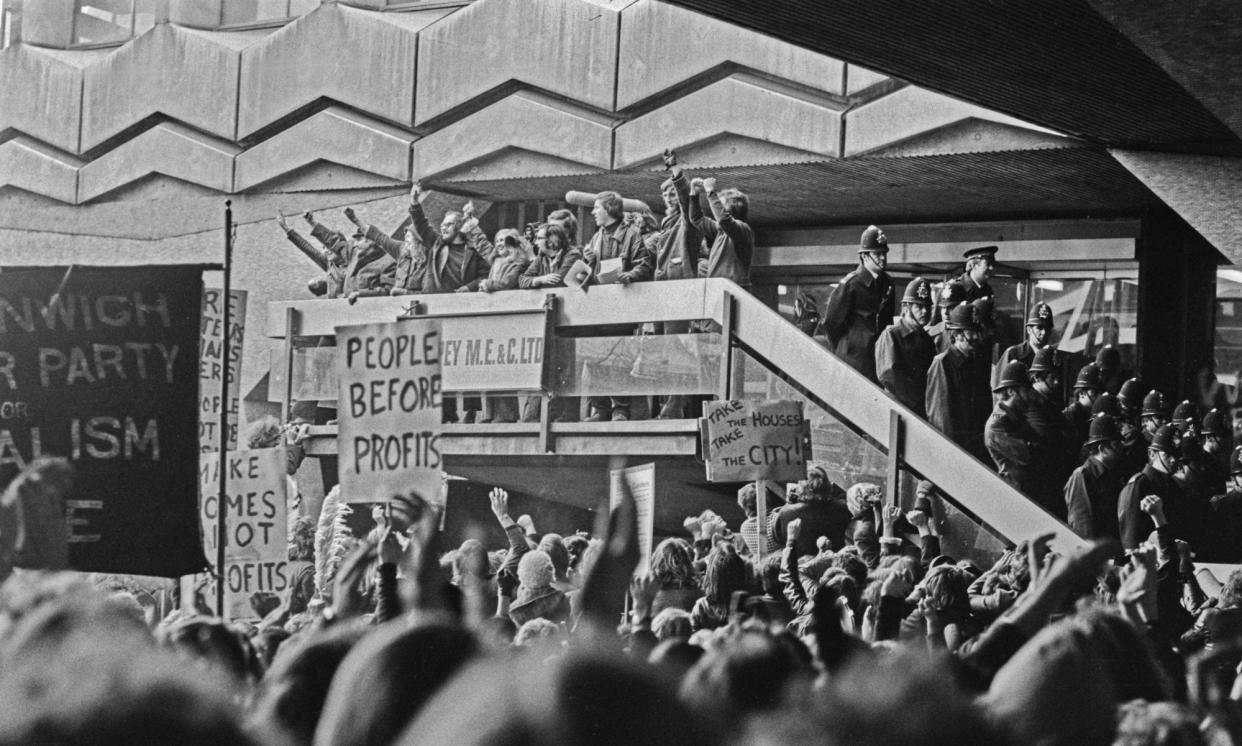Fifty years on, could we see another Centre Point-style housing protest?

One cold afternoon in January 1974, the future treasurer of the Labour party, Jack Dromey, donned the uniform of a Burns International Security Services guard and climbed the stairs to the glass doors of the Centre Point tower.
Dromey and his fellow undercover housing campaigner, Andy Carter, were the arrowhead of an audacious occupation of the central London block that had been left vacant for a decade by its speculative developer, Harry Hyams, becoming a symbol of the housing crisis under Edward Heath’s government.
“They said to the [real] security guards: ‘We’ve come to take over,’” recalled Ron Bailey, who helped plan the stunt that involved nearly 80 protesters lying in wait to surge into the building from bus queues, the tube station and the Oxford Street branch of Wimpy.
The real security guards were bamboozled as it wasn’t time for a shift change, and had little chance to react.
“By that stage we were all halfway up the stairs,” Bailey said.
Now 80, Bailey is marking this week’s 50th anniversary of the occupation to urge a new generation to take “nonviolent, imaginative and direct” action to demand change to today’s housing conditions.
The latest government figures show about 250,000 homes in England have stood vacant for at least six months; almost 1.3m households are waiting for social housing; and about 88,000 households in social housing are living with serious damp and mould. Housing is the fifth most important issue for voters (up from seventh at the 2019 general election), above crime, education and Brexit, but below the economy, health and immigration.
“When houses are left empty for a long time, I would call upon people to occupy them,” Bailey said. “Certainly [if empty for] two years plus.”
Renters unions often stage direct action to block evictions, but have not recently planned protests that have grabbed nationwide attention. By contrast, among the squatters, teachers, lawyers, Labour councillors, academics and anarchists who staged the two night occupation of the 34-storey Centre Point were film-makers from the current affairs programme World in Action, which soon aired a documentary about the protest, and the campaigning journalist John Pilger.
“There was a massive homelessness problem – lots of children in care because [their families] were homeless, people living in bed and breakfasts,” Bailey said. “It was pretty much like now.”
A first occupation attempt four months earlier was halted at the last minute after police were tipped off by a campaigner bragging about the plans to impress a woman he fancied, Bailey said.
This time they poured into the building with sleeping bags, loaves of bread, Marmite and music systems. They immediately called the media, generating rolling radio interviews and a street crowd that grew to about 2,500 people. They fixed a message across the tower’s windows that read: “We’re just wild about Harry” and hollered through a megaphone to passersby about the housing crisis.
Some of the protesters were veterans of 1960s squatting campaigns against “the atrocious conditions in homeless hostels, where husbands weren’t allowed in and wives were kicked out after three months and the kids taken into care – destroying family life”, Bailey said.
He believes the Centre Point action helped persuade the government that councils should do more to hand over empty properties to squatters groups amid a festering homelessness crisis that only a few years earlier had inspired the TV play Cathy Come Home.
“We deliberately didn’t dress scruffy – clean shirts, cleaner trousers, hair reasonably tidy so we didn’t attract attention,” said Bailey. “It did not look like a hippy invasion.”
Mary Evans Young, 78, who worked for Shelter at the time, recalled wearing a blue crochet hat, maxi skirt, pantaloons and purple boots.
“We were excited and gobsmacked about how easy it was,” she said. “It was also bloody cold.”
She recalled two protesters headed quickly for the top floor because “their ambition was to have sex in the highest place in London”. A branch of the striking National Union of Mineworkers sent a food hamper that was winched up by rope.
The protest ended in violence when some of the occupiers decided they didn’t want to leave as planned after 48 hours. Fights broke out, police helmets flew and eight people were injured. It was not how the organisers intended it. Squatting campaigners were still negotiating with councils to take on empty homes and needed to maintain good faith with the authorities.
Reflecting on the protest, Evans Young said she too would like to see a new era of people taking direct action on housing.
“I so wish they would, but it is almost as if people have been crushed,” she said. “We had a housing crisis but it was nothing compared to now.”
A high-profile action could inspire otherwise “cowed” people. They are “desperate for something”, she said.

 Yahoo News
Yahoo News 
